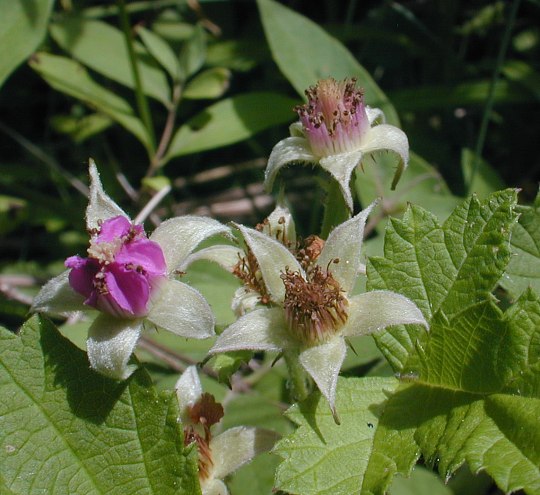
Alternate compound leaves occur at intervals along the stems; they are usually trifoliate, however on uncommon occasions first-year stems may produce simple-pinnate compound leaves with 5 leaflets. The petioles of the compound leaves are ½–1" (1.25–2.5 cm.) in length; they are light green to light purple, sparsely to moderately prickly, and finely hairy to hairless. At the base of each petiole, there is a pair of stipules that are ¼–½" (6-12 mm.) long and linear in shape. The terminal leaflets of the compound leaves are larger in size than the lateral leaflets. Terminal leaflets are 1¼–2½" (3–6 cm.) long and a little less across; they are ovate, oval, or broadly rhombic in shape. Occasionally the terminal leaflets are shallowly cleft into 3 inconspicuous lobes. The lateral leaflets are ¾–2" (2-5 cm.) long and a little less across; they are ovate to obovate in shape. Both terminal and lateral leaflets have large coarse teeth along their margins; these teeth are dentate or double-dentate. These leaflets also have broadly wedge-shaped bases and their tips are usually obtuse (less often broadly acute). The terminal leaflets have petiolules (basal stalklets) that are 4-10 mm. long, while the lateral leaflets are sessile or nearly so.
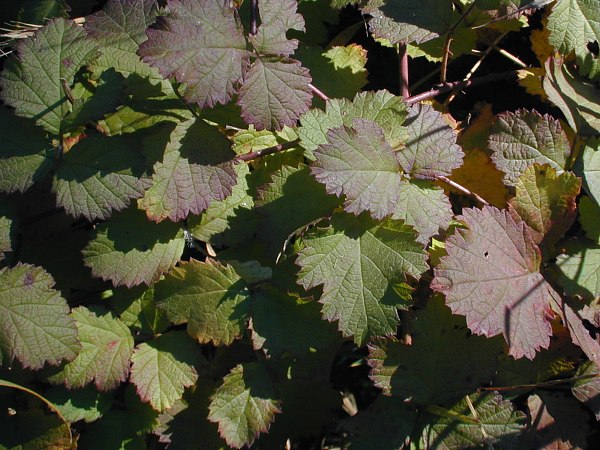
The upper leaflet surface is medium green, hairless or nearly so, and indented along its veins; this surface can become greenish red to dark red when it is exposed to sunlight during cool weather. The lower leaflet surface is white and canescent; a few slender prickles occur along the underside of the central vein. Either solitary flowers or small cymes of 2-10 flowers occasionally develop from the axils of the compound leaves on second-year stems. Each flower spans about ½" across, consisting of 5 rose-pink petals, 5 sepals, and the reproductive organs. The petals are oblanceolate in shape and recurved; they are shorter than the sepals. The sepals are lanceolate-triangular in shape; the inner sides of the sepals are white from appressed silky hairs, while their outer sides are light green, becoming prickly near the base. In the center of the flower, there is a column of white styles; this is surrounded at some distance by a lower ring of stamens with pinkish white filaments and yellow to brown anthers. The pedicels, peduncle, and branches of the inflorescence are light green, terete, sparsely to moderately prickly, and finely hairy. All of the prickles on this woody plant are 0.5–2 mm. long, slightly curved, slender, and wider at their bases than their tips.
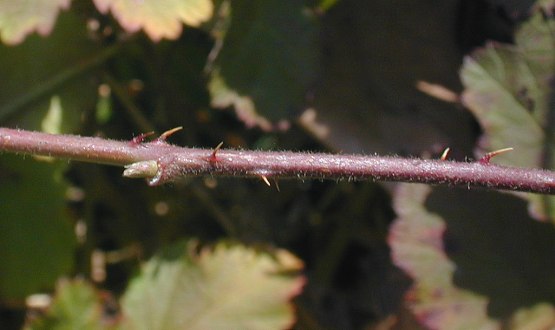
The blooming period occurs during late spring or early summer, lasting about 3 weeks. Afterwards, fertile flowers (if any) are replaced by compound drupes that become mature during mid- to late summer. Mature compound drupes are up to ½" (12 mm.) across, globoid in shape, bright red, and shiny; like the fruits of other raspberries, they detach readily from their receptacles. Each drupelet within a compound drupe contains a single hardened seed. The root system consists woody crowns with coarse spreading roots.
Cultivation: The preference is full sun to light shade, moist to dry-mesic conditions, and soil containing loam or sand. Other soil types are probably tolerated. This woody plant can spread aggressively, smothering adjacent plants, and it can be difficult to get rid of.
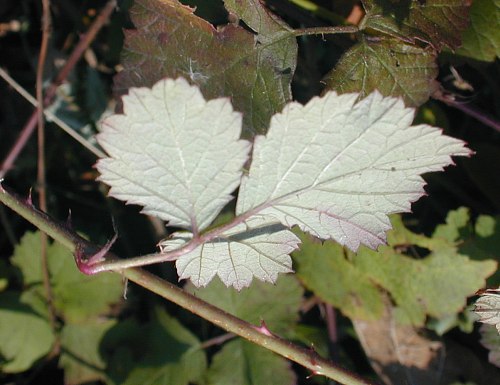
Range & Habitat: Naturalized colonies of Japanese Raspberry (Rubus parvifolius) have been observed in two counties of Illinois, where this non-native woody plant is currently rare (see Distribution Map). So far, it has been found in scattered states across the northeastern and Midwestern areas of the United States. This woody plant was introduced by the Soil Conservation Service during the 1930s as a possible control for soil erosion on hillsides. It was cultivated even earlier at the Arnold Arboretum in Massachusetts (Widrlechner & Rabeler, 1991), from where it escaped. Japanese Raspberry is native to east Asia (China, Korea, Japan) and Australia. Habitats in Illinois and other areas of the United States include disturbed open woodlands, woodland edges, sandy and non-sandy hillsides along railroads and roads, and powerline clearances in woodlands. So far, this woody plant has been found in various disturbed areas, although it could invade higher quality natural areas.
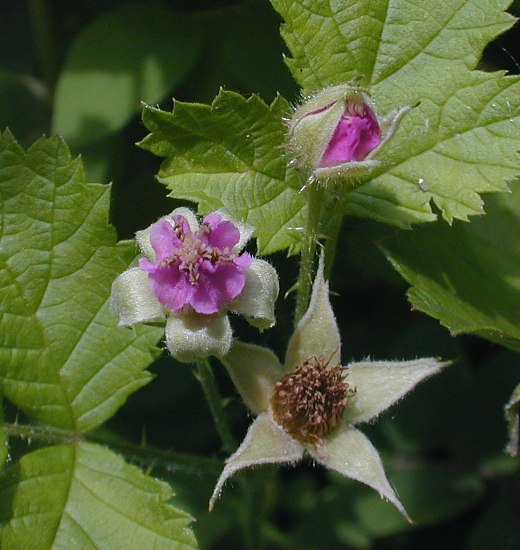
Faunal Associations: Very little is known about the floral-faunal relationships of this woody plant in North America at the present time. In general, the flowers of raspberries (Rubus spp., subgenus Idaeobatus) attract small to moderate-sized bees, beetles, and other insects because of their nectar and pollen. Many insects feed on the foliage and other parts of these woody plants, including beetles, aphids, leafhoppers, treehoppers, larvae of sawflies, larvae of moths, and walkingsticks. Their fruits are eaten primarily by songbirds and upland gamebirds (the latter also feed on buds and foliage occasionally). However, many mammals and woodland-dwelling turtles also eat the fruits. These animals can spread the seeds of the fruits to new locations. White-tailed Deer sometimes browse on the foliage of these plants, while rabbits feed on the stems during winter. The dense mounding habit of Japanese Raspberry (Rubus parvifolius) probably provides good protective cover for various kinds of wildlife and nesting habitat for some songbirds.
Photographic Location: A powerline clearance at Busey Woods in Urbana, Illinois. After persisting and slowly spreading for a number of years, the colony of Japanese Raspberry (Rubus parvifolius) at this site has since been destroyed by city park personnel.

Comments: Japanese Raspberry (Rubus parvifolius) doesn't closely resemble any of the native Rubus spp. in Illinois. It can be identified by its non-showy flowers with small pink petals, woody stems that are both prickly and hairy, relatively low growth and mounding habit, relatively small leaflets with obtuse tips, compound leaves with primarily 3 leaflets (uncommonly with 5 leaflets), and red mature fruits. The leaflets of Japanese Raspberry are able to resist subfreezing weather, sometimes persisting until mid-winter. While this woody plant is potentially useful as a ground cover for landscape purposes and for soil erosion control along hillsides, its use is not recommended because it has a tendency to persist and spread, smothering adjacent vegetation. In addition, fruit-eating birds can easily spread its seeds to new locations. A scientific synonym of this woody plant is Rubus triphyllus. In Australia, it is called Small-leaved Bramble.